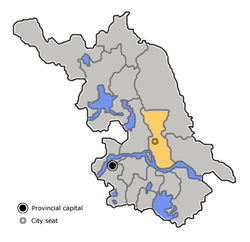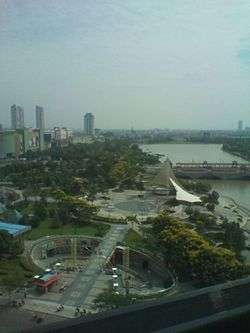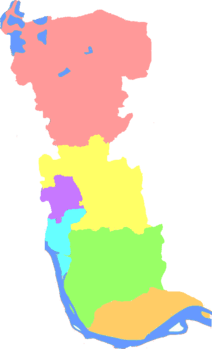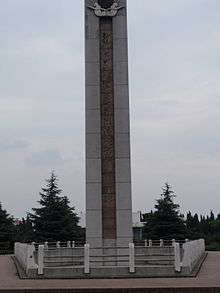Taizhou, Jiangsu
| Taizhou 泰州市 | |
|---|---|
| Prefecture-level city | |
|
Taizhou | |
 Taizhou is highlighted on this map | |
 Taizhou Location in China | |
| Coordinates: 32°27′N 119°55′E / 32.450°N 119.917°ECoordinates: 32°27′N 119°55′E / 32.450°N 119.917°E | |
| Country | China |
| Province | Jiangsu |
| Government | |
| • Mayor | Xu Guoping (徐郭平)[1] |
| Area | |
| • Prefecture-level city | 5,787.254 km2 (2,234.471 sq mi) |
| • Urban | 1,567.1 km2 (605.1 sq mi) |
| • Metro | 1,567.1 km2 (605.1 sq mi) |
| Population (2010 census) | |
| • Prefecture-level city | 4,618,937 |
| • Density | 800/km2 (2,100/sq mi) |
| • Urban | 1,607,108 |
| • Urban density | 1,000/km2 (2,700/sq mi) |
| • Metro | 1,607,108 |
| • Metro density | 1,000/km2 (2,700/sq mi) |
| Time zone | China Standard (UTC+8) |
| Postal code |
225300 (Urban center) 214500, 225400, 225500, 225600, 225700 (Other areas) |
| Area code(s) | 523 |
| GDP | ¥270.2 billion (2012) |
| GDP per capita | ¥58,478 (2012) |
| Major Nationalities | Han |
| County-level divisions | 6 |
| Township-level divisions | 105 |
| License Plate Prefix | 苏M |
| Website |
www |
| Taizhou | |||||||||||||
|
"Taizhou", as written in Chinese | |||||||||||||
| Chinese | 泰州 | ||||||||||||
|---|---|---|---|---|---|---|---|---|---|---|---|---|---|
| Postal | Taichow | ||||||||||||
| |||||||||||||
Taizhou (Chinese: 泰州; pinyin: Tàizhōu) is a prefecture-level city in central Jiangsu Province in eastern China. Situated on the north bank of the Yangtze River, it borders Nantong to the east, Yancheng to the north and Yangzhou to the west.
The 2010 census counted its population at 4,618,937 of whom 1,607,108 live in the built-up (or metro) area made of three urban districts, (Hailing, Jiangyan and Gaogang).[2] Two county-level cities have more than 1 million inhabitants, Xinghua with 1,253,548 inhabitants and Taixing with 1,073,921 inhabitants, comprising two of the most important county-level cities in China. Hu Jintao, former General Secretary of the Communist Party of China considered Taizhou his home town as did Mei Lanfang, one of the most famous Peking opera artists in modern Chinese history.
Administration
The prefecture-level city of Taizhou administers six county-level divisions, including two districts and four county-level cities.
These are further divided into 105 township-level divisions, including 91 towns, eight townships and six subdistricts.
| Map | Subdivision | Hanzi | Pinyin | Population (2010) | Area (km2) | Density |
|---|---|---|---|---|---|---|
| City Proper | ||||||
| Hailing District | 海陵区 | Hǎilíng Qū | 594,656 | 337.9 | 1,760 | |
| Suburban | ||||||
| Gaogang District | 高港区 | Gāogáng Qū | 283,807 | 301.7 | 941 | |
| Jiangyan District | 姜堰区 | Jiāngyàn Qū | 728,645 | 927.53 | 786 | |
| Satellite cities (County-level cities) | ||||||
| Jingjiang | 靖江市 | Jìngjiāng Shì | 684,360 | 665.6 | 1,044 | |
| Taixing | 泰兴市 | Tàixīng Shì | 1,073,921 | 1,169.56 | 8918 | |
| Xinghua | 兴化市 | Xīnghuà Shì | 1,253,548 | 2,394.96 | 523 | |
| Total | 4,618,937 | 5,787.25 | 798 | |||
Geography and climate
Taizhou lies at the confluence of the Yangtze River and the Jinghang Canal (Grand Canal of China), in the south-central Jiangsu Province, which is on the north bank of lower reaches of the Yangtze River, the south end of Jianghuai Plain. Its latitude ranges from about 32° 02′ — 33°11′ N and longitude 119° 38′ — 120° 32′ E, with a total area of 5,793 square kilometres (2,237 sq mi).
Neighbouring Areas: Yangzhou to the west, Nantong to the east, and Yancheng to the north.
History
Taizhou City has a long history and was first known as "Hǎiyáng" (海阳/海陽) in the Spring and Autumn period; it was later called "Hǎilíng" (海陵) during the Western Han Dynasty. It became Hailing County in 117 B.C. and was famous during the Eastern Jin Dynasty on a par with Jinling (Nanjing) and Guangling (Yangzhou), Lanling (Changzhou). During the Southern Tang Dynasty it was named "Taizhou Prefecture", which means 'Peaceful country and lucky citizens' a name it has kept for 2,100 years.
Taizhou became independent of its larger neighbour Yangzhou in the 10th century AD. Under the Ming dynasty (1368–1644), the salt trade was centered here, and like Yangzhou, Taizhou was the home of many wealthy salt merchants. In 1952, the construction of a new canal and ship locks linked Taizhou with the Yangzi River.
With a history of over 2100 years, Taizhou has enjoyed the reputation of being the "Ancient County of the Han and Tang Dynasties and the Famous District Alongside the Coast of the Yellow Sea". Through the ages, it has seen gatherings of many talented people and famous merchants. Taizhou has always been a political, economic, cultural and transportation center in Central Jiangsu Province. The hometown of great artistic Masters like Shi Nai'an, Zheng Banqiao, and Mei Lanfang, etc., Taizhou is also the birthplace of the Navy of Chinese People's Liberation Army. Taizhou is now one of the famous historical and cultural cities of Jiangsu Province.
Economy
Taizhou is a center for flour mills, textile works, fishing net manufacturing, and other industries based on local agriculture.
Having a favorable geographical location, rich resources and solid economic foundation, Taizhou was approved by the State's Council to be one of the open coastal cities. In the past 20 years, the economic growth has remained stable with an average annual growth rate exceeding 10%. It is one of the central cities inside the Yangtse River Delta with its developed industry, convenient transportation and prosperous commerce. In 2009, the GDP reached RMB 165.1 billion yuan, the GDP per capita RMB 35,498 yuan, the fiscal revenue RMB 34.4 billion yuan, the total amount of bank deposits RMB 188.5 billion yuan. Five county-level cities or districts are ranked among the "China's Top 100 Counties with Greatest Comprehensive Power". It boasts numbers of large-sized enterprises or groups, such as Chunlan Group Corp.
Taizhou was among the first few cities in Jiangsu to be recognized as having a famous cultural history. In 1990, Heheng village in Jiangyan County was awarded Global 500 Roll of Honor by the United Nations Environment Programme (UNEP) because of its success in protecting the environment while increasing the grain yield and its wide use of marsh biogas ponds.
International relations
Twin towns – Sister cities
Taizhou is twinned with:
|
|
Transportation
Beijing–Shanghai Expressway京沪高速公路 (G2) and Yancheng-Jingjiang Expressway 盐靖高速公路(S29) pass through the city from north to south, and Qidong-Yangzhou Expressway 启扬高速公路 (S28) from west to east.[6]
Taizhou Municipality has two Yangtze River crossings, the Taizhou Yangtze River Bridge from Gaogang District to Yangzhong and the Jiangyin Yangtze River Bridge from Jingjiang to Jiangyin.
The routes to get to Taizhou includes:
- Take buses from Shanghai or Nanjing through Beijing–Shanghai Expressway京沪高速公路.
- Take trains from Beijing through Xinyi-Changxing Railway (新长铁路) or Nanjing through Nanjing-Qidong Railway (宁启铁路).
Military
Taizhou is headquarters of the East Sea Fleet of the People's Liberation Army Navy.
Companies headquartered in Taizhou
- Chunlan Group Corp
- Linghai Motocyle Corp
- Yangtze River Pharmaceutical Group
- Oberon Dishwashing Equipment Manufacturing Co. Ltd
Tourism
- Gardens and Parks
- Qintong Boat Festival, Jiangyan (溱潼会船节)
Qintong Boat Festival is held in Qingming (around April 4–6) every year. During the festival boats from nearby villages and towns converge on Xique Lake for a few days of rejoicing. Theatrical performances, dragon and lion dances, and other folk dances are staged right on board the boats.
- Xique Lake, Jiangyan (喜鹊湖)
The lake located in Qingtong town, 15 kilometres (9 miles) north of Jiangyan city. The water comes from the Nanhu (南湖), Xique (喜鹊湖), and Beihu (北湖) rivers. It is part of Qintong Swamp.
- Père David's Deer Reserve, Jiangyan (麋鹿故乡园)
Biggest reserve outside of Dafeng.
- Taizhou Park
- Heheng Agricultural Tour, Shengao, Jiangyan
- Museum
- Navy Birthplace Museum
- Hu Jintao Birthplace Museum, Jiangyan
- Gao Ershi Museum, Jiangyan
- Mei Lanfang Garden, opposite of 'Old Street;'
Colleges and schools
- Jiangsu Taizhou Zhongxue (江苏省泰州中学)
- Jiangsu Jingjiang Zhongxue (江苏省靖江中学)
- Taizhou Dier Zhongxue (Second Middle School in Taizhou Jiangsu Province)
- Jiangsu Jiangyan Zhongxue (江苏省姜堰中学)
- Jiangsu Taixing Zhongxue (江苏省泰兴中学)
- Xinghua Middle School (江苏省兴化中学)
References
- ↑ "About Mayor". Taizhou City Council. Retrieved 2 April 2014.
- ↑ http://www.citypopulation.de/php/china-jiangsu-admin.php
- ↑ "Sister-city relationships". Taizhou City Council. Retrieved 2 April 2014.
- ↑ Hassinen, Raino. "Kotka - International co-operation: Twin Cities". City of Kotka. Retrieved 2013-10-22.
- ↑ "Some 15 Finnish towns have twinned with friendship cities in China". Helsingin Sanomat International Edition. 2013-06-20. Retrieved 2013-07-29.
- ↑ "Taizhou". Baidu Baike. Retrieved 2 April 2014.
External links
- Government website of Taizhou (available in Chinese and English)
- Official Travel and Tourism Website for Taizhou (available in English)
- Taizhou comprehensive guide with open directory (Jiangsu.NET)
- Qintong Boat Festival



